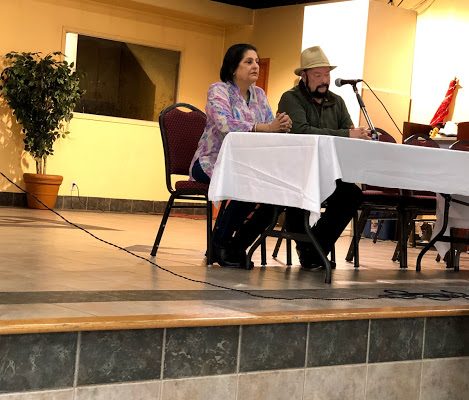Toronto, Mar 21 (Canadian Media): Canadian Media’s Asha Bajaj interacts with Barry Brown, author of “Humanity: The World Before Religion, War & Inequality”
#Jewish; #HinduSabhaMandir; #Brampton, #Ontario; #BarryBrown; #PulitzerPrize; #Humanity:TheWorldBeforeReligion,War&Inequality;
Excerpts:
1. Your book, Humanity: The World Before Religion, War & Inequality has gained a lot of praise from historians in India and North America. But before we go into that, please tell us a bit about your background and early childhood.
I grew up in Toronto and was raised Jewish although most of my family was not very religious. My earliest ambition was to be a theoretical physicist but my math skills were weak, so while I kept reading books and articles about Science, my focus began to shift into history and literature. By the time I was in High School, I had decided to become a writer and so I immersed myself in meeting people from different backgrounds and lifestyles, reading about different cultures, histories, and the personal struggles of people who faced discrimination and other hardships in their life. At home and School, I was often punished and beaten for nothing more than thinking independently, so I had an immediate empathy with others who faced similar uphill battles. By the end of my time in High School, I had started my fledgling career as a writer. I had my first paid poetry reading at a Toronto library and my first play was slated for production. However, the Director who chose my play suddenly moved out of Toronto, so it was never staged.
In my late teens, I decided to drop out of High School and leave my family home. I bought a train ticket for Vancouver and rode the rails to the West Coast. When I arrived in Vancouver, I already had a wide range of experiences and personalized education. I’d become a vegetarian, begun to practice yoga, spent time studying the I Ching, the Baha’i philosophy, Japanese poetry, and many other subjects. My life in Vancouver seemed not much different from Toronto.
I wanted to expand my way of thinking so when I was given the chance to live in an abandoned logger’s cabin on top of Mt. Tuam on Saltspring Island (B.C.), I took it. I communed with others and experienced a very rugged life. I cut wood for my cast iron stove and heater, gathered water from a mountain stream, and generally lived a life close to that of the early settlers. This experience also had its limits and one day while on a ferry boat traveling back to Vancouver, I met a young man with the Hare Krishna books and began to read it. He told me the group offered free vegetarian meals, so I stopped in at the Vancouver Temple. Not long after I joined the group, I shaved my head and began living the life of a Brahmachari monk. It was the start of a three-year experience that helped me gain insights that would later form the foundation of my book, Humanity: The World Before Religion, War & Inequality.
2. Tell us about your Book?
Humanity is the first book to examine history as the two-part story of one human family. The first part investigates how humans created a common civilization of travel, trade, and language in 99.9% of history before the first war. The second part looks at the causes of the war and follows its consequences to the modern world.
The path to the book began when I came across an obscure quote from the Greek philosopher Aristotle who said, “The Jewish people are descended from the Brahmin priests and philosophers of Ancient India.”
Jewish history begins about 6,000 years ago with the story of the Garden of Eden and the “fall of mankind.” The Jewish Bible says Eden was located at the eastern end of a larger land called “Havilah.” According to the 20-volume, 1906 Jewish Encyclopedia, more than 2,000 years of Jewish and Christian traditions agree that Havilah was India.
From my studies as a Hare Krishna Brahmin, I knew that the Mahabharata and the history of Ancient India ended about 6,000 years ago with the tale of the Kurukshetra War. I began to wonder if the end of one history and the start of the other were related. The more I pursued this line of investigation, the more connections I found that made it clear that Aristotle was correct. The ancient Hebrew people of the Jewish Bible were related to the families that fought in the war and migrated to Mesopotamia from the Indus River Valley Civilization at the time of its collapse from climate change c 2000 BC. That climate change and migration event was the source of the Bible’s tale of Noah.
At first, my investigation was focused only on the religious aspects of this connected history. But as I got deeper into it, it became a broader story about humanity itself and how civilization evolved and changed over time. The story of humanity is, of course, vast and almost never-ending, so my book looks at the beginnings of things – why Homo Sapiens survived and Neanderthals died out, how symbolic communication (paintings and writing) began and spread, the first School of 10,000 BC, the creation of currency, burial grounds, social governments, social, gender and religious divisions and so on.
3. You write that the war at the end of the Mahabharata is the same story that
begins the Jewish Bible. How did you discover that the two histories are
connected?
After noting the time frame similarities between the two events, I began to wonder if the idea of the “fall of mankind” and Kurukshetra was connected as a momentous event in human history. Was Kurukshetra the world’s first organized, large-scale war? I found an article in Scientific American magazine that claimed there is no archaeological or fossil evidence of human war earlier than about 6,000 years ago. Many tales from ancient societies including Greece and Rome also asserted there was a time in history before war. In my own investigation, I learned that there are no war weapons among the three million years of Stone Age tools, no images of human on human violence in the cave paintings of 40,000-10,000 years ago, and no defensive walls around towns or villages until about 6,000 years ago. Those findings and more kept alive the likelihood that India’s war story was based on a true event even if some details were exaggerated.
4. Can you elaborate on the genetic connection between India and the Hebrews?
Further investigation of the India-Hebrew connection showed a genetic family relationship. Among Jews there is a tribe of people called Levites who are descended from the family of Moses and Aaron (c 1300 BC) and they are considered to be born priests in the same way as born Brahmins. It turns out that there are strong chromosomal family links between some of the Levites and various Brahmin families including the Yadavas and the Brahmins of West Bengal.
5. Many people think the tale of the Kurukshetra War is a fable-like the Bible’s story of Eden. How certain are you that both these stories are based on real events?
There is currently no way of knowing for absolute certainty that these tales were inspired by real events. However, the balance of probabilities weighs heavily in their favor when they are examined as fragmented memories of the world’s first war and the end of “generation Eden.”
I have explained how they relate to this event on their own, but the second set of compelling evidence is found in the Indus River Valley civilization that follows the war period. The Indus River Valley confounds historians because it has no palaces, no religious temples, no organized writing system, and no warriors or history of war when the civilizations of its mighty neighbors – the empire of Sargon the Great in Mesopotamia and the Pharaohs of Ancient Egypt – are full of temples, class divisions, elite priests, war machinery and so forth. Why is the Indus so spectacularly different when it is obviously quite advanced in terms of city planning, Math and measurements, civic organization, extensive travel, and trade etc.? They obviously had a strong philosophy that guided them during their roughly 1,000-year lifetime (c 3000-2000 BC), but what was it? The utter absence of religious temples and warriors made me look at other civilizations that followed this path and they all developed after the devastation of their previous society. After the horrors of WWI, many nations began destroying war weapons in the hope that would end the possibility of war. During the French and English Revolutions, Catholic Churches were closed and destroyed because they had abused their official powers and exploited large numbers of people. So it seemed likely the Indus rejected all the symbols of the earlier Vedic period for the same reason – the social decay and destruction of the Great War caused by the caste system.
I further reasoned this founding philosophy was likely inspired by Krishna’s advice to Arjuna in the Bhagavad-Gita when he tells his friend to “abandon” all his attachments to the existing social divisions. There is even a relic from the Indus called the Warrior Seal which I believe is essentially a mural depicting the Kurukshetra War story and may have been used to explain that history to newcomers to the Indus.
6. If the Jewish Bible starts in India what other parts of Jewish history come from India?
Stripped of its religious themes, the Noah story (c 2000 BC) is a tale about climate change and three waves of migration into Europe, Mesopotamia and Northeast Africa from Noah’s unnamed homeland. My research shows Noah came from the Indus River Valley around 2000 BC. At that time extreme climate change events – floods, cold weather, droughts, etc. – are recorded in China, Ancient Egypt, and Mesopotamia which caused early civilizations in all those areas to collapse. The Indus was the worst hit. Many years of floods were followed by decades of drought and finally, its residents abandoned it. Some returned to other parts of India but there is also evidence showing large waves of migration from that region into Europe, Mesopotamia, and Northwest Africa at this time.
The word “Hebrew” means “homeless wanderers from the East” and was the name the local people of Mesopotamia gave to the Indo-Semitic migrants from the Indus who arrived there when their homeland was destroyed.
7. I was surprised to learn the Jewish Star of David and other parts of Jewish
culture begin in India. Please explain this.
There is nothing in the Jewish Bible that explains the origin of the Star of David. Moreover, this image has not always been the most prominent symbol of the Jewish people. In my book, there is an illustration from the early 1800s. It shows the French Emperor Napoleon liberating the Jews from oppressive laws that banned them from many areas of French life. In this drawing, the Jewish men are depicted with long hair and beards, and the Jewish woman is presented with the stone tablets of Moses’ 10 commandments and a menorah (an 8-branches candelabra used for the Hanukkah ceremony). There is no Star of David anywhere in the picture.
I knew the image of interlocking triangles had a long history as an Indian symbol for the energy of the heart (heart chakra). So I did some research. In the Bible, the character of David becomes a beloved ruler in the kingdom of Ancient Israel. His son, Solomon, builds a spectacular temple dedicated to his father. According to the Bible, Solomon decorates this temple with vast amounts of gold he gets from a faraway place called Ophir. The German historian Max Muller had identified Ophir as a town on the west coast of India. At this time (c 1000 BC), the Yadavas are the ruling family of this Indian town. My speculation is that Yadava traders and artisans brought the gold to Solomon and fashioned a glorious heart chakra in a central place. To gain fame, the star shape must have been distinctive and unusual and so it became known as the “Star of David’s Temple.”
8. Most historians are baffled by the Indus Valley Civilization. They left no written records and there is very little known about what happened during its 1,000-year history. You say it was the world’s first planned democracy and that it was inspired by the teachings of Krishna. Why?
The key to understanding the Indus is what is not there – all aspects of society associated with social divisions and war culture. The absence of horses is another clue. They were abandoned because its leadership saw them as symbols of warriors and elitist wealth. The lack of palaces and equal-sized housing found in all its towns and villages indicates a culture without social divisions found in other civilizations. There is also a pottery fragment that may indicate they used a style of democratic voting 2500-1500 years before its evolution in Ancient Greece (c 500 BC). This fragment shows a stick figure holding a bow and arrow in hands of his outstretched arms that face in opposite directions. Nearby is a hashtag that is a 40,000-year-old symbol for human lands. In ancient Democracies, votes were sometimes decided by placing dark and light stones into a jar. The stick figure image may have come from the period of the Indus collapse when people were forced to decide whether to “pray and stay” on the land or “pray and leave” it and so cast stone ballots into a pottery jar.
9. The Bible is a sacred book to both the Jewish and Christian communities. How have they responded to your research? This is all fascinating. Tell me, what inspired you to begin this research?
People of all faiths and even atheists have responded to my book with great enthusiasm and interest. My first comment came from Dr. Abdul Hai Patel of Ontario Multifaith Council who wrote, “Congratulations on this masterpiece of research.”
Yaen Vered, Canadian Representative of the Israeli Antiquities Authority said, “I don’t know if you are right or not but you will change history if you are.”
Rev. John J. Mastandrea of the Metropolitan United Church (Toronto) told me, “Barry, you’ve discovered the Rosetta Stone for understanding early Bible history.”
Because they don’t understand why people follow religions, atheists typically have more interest in religion than other people and because my book explains religious evolution in a historical context they are fascinated.
10. What lessons do you think all this history has for the modern world?
Much of modern commentary in history, science, politics, and entertainment repeats the notion that humans have always been at war, that we are naturally disposed to fear strangers and differences and that we have constantly battled over land and resources. This is utterly false and not supported by any evidence. War and social fears are taught and must be constantly reinforced or they will disappear. Of the 9 million species of life on Earth, only three engage in war – some ants, some chimpanzees, and some Humans. And of those three, Humans are the least war-like.
Human language is a great example. There are four base language groups that account for more than 95% of all spoken languages. The only way a common language can take root and spread is if the cultural soil is one of honesty and friendship. If someone’s words are not considered honest and reliable, they will not be shared and language will evolve in isolated groups separated by suspicion. But there is evidence of regular long-distance trade in Southern Africa from almost 500,000 years ago, long before modern humans. This suggests human ancestors already had a common culture of travel, friendly trade, and shared language.
11. What is your contribution to the community?
Someone once said, “If you get people asking the wrong questions, it doesn’t matter what answers you give them.” I love asking questions and I hope that if my book gets people asking their own new questions, then I’ve done my job.
(Asha Bajaj)





